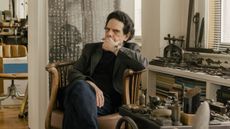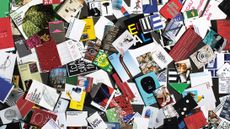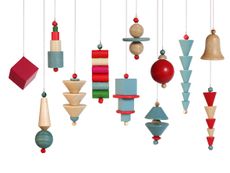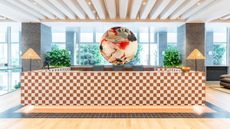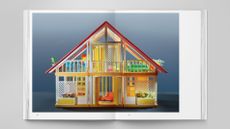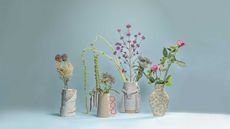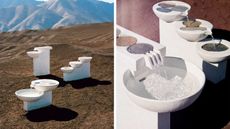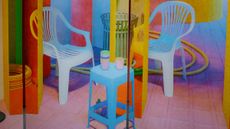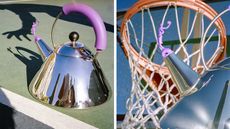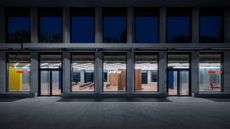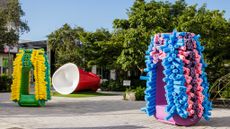HRH Prince Charles and Sir Jony Ive on designing for a better world
Founded and led by His Royal Highness The Prince of Wales (as he was at the time of publication) and Sir Jony Ive – who headline the August 2022 issue of Wallpaper* – the Terra Carta Design Lab celebrates young designers developing high-impact, low-cost solutions to the climate crisis. Ive speaks exclusively to Deyan Sudjic, Wallpaper* contributing editor and director emeritus of the Design Museum, London
- (opens in new tab)
- (opens in new tab)
- (opens in new tab)
- Sign up to our newsletter Newsletter
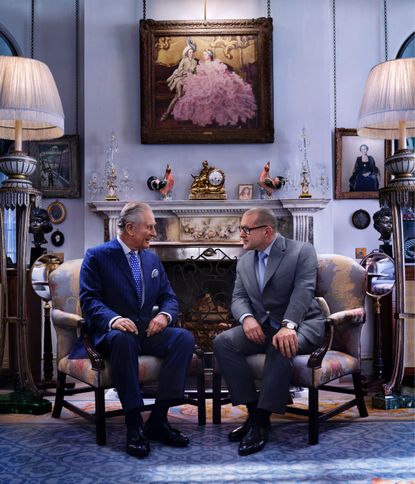
Sir Jony Ive signs off the website of his creative collective, LoveFrom, with two startling, contradictory words: ‘Love’ and ‘Fury’, connecting them with a meticulously drawn ampersand. They suggest a more complicated and surprising designer than the purist who gave the enigmatic first-generation iPhone its Dieter Rams-inspired calculator interface.
Ive is unfailingly polite, solicitous and considerate in conversation, and yet every so often he uses the word ‘fury’ or ‘furious’, or ‘angry’. It makes him sound a bit like William Morris, who gave up design to campaign for socialism, complaining within the hearing of his clients of spending his life ‘ministering to the swinish luxury of the rich’. Ive certainly isn’t giving up design, but he suggests that, when discussing work in his studio, he is sometimes arguing with himself: ‘mostly it is an internal monologue’. He belongs to a generation of designers who grew up reading Victor Papanek’s Design for the Real World, which made the notorious claim that ‘there are professions more dangerous than industrial design, but not many.’
His career to date has been inextricably associated with the giant company that has done more than most to define modern industrial production, and perhaps even modern life. Though he stepped down from the chief design officer role in 2019, he continued to work with Apple until this year. His current clients include Ferrari and Airbnb.
Terra Carta: a new charter for the planet

The Terra Carta Seal by LoveFrom
Alongside his work for industry behemoths, Ive recently designed a seal for the Prince of Wales’ Terra Carta campaign, with the words ‘For Nature, People and Planet’ around the edge rendered in the specially drawn serif font, derived from the work of the 18th-century printer John Baskerville, that Ive reserves for his personal projects. The seal has an elegance and emotional punch that somehow hints at the sensibility of both William Blake and Damien Hirst.
Terra Carta, named in a conscious echo of the 13th-century Magna Carta, is a document designed to guide business in averting climate catastrophe. Magna Carta, which promised trial by jury and the abolition of cruel and unusual punishment, was written with considerable elegance by the Archbishop of Canterbury of the time. The new Terra Carta, which aims to show that capitalism and enlightened self-interest are compatible with saving the planet, may have a Latin name, but its vocabulary is unsurprisingly accented by the language of modern management theory. With its frequent references to ‘road maps’, ‘value chains’ and ‘game changers’, Terra Carta aims to identify 13 fruitful areas for investment, including biomimicry, electric flight propulsion, carbon-neutral construction, nuclear fission, and green infrastructure.
It’s an approach that has drawn the attention of Greenwash.Earth, an Extinction Rebellion-backing activist group that calls out organisations that ‘claim to care about the natural world while knowingly destroying it’. They call Terra Carta ‘a great idea’ and say ‘we don’t think Terra Carta is greenwashing’. But they have expressed scepticism about some of the 450 organisations, which include HSBC and BP, that have signed up to support the document.
As chancellor of the Royal College of Art (RCA), Ive does not confine himself to dressing in a colourful cod-medieval outfit once a year to officiate at the degree ceremony. He has worked with the Prince to kick-start what he calls a design lab at the college, to support the aims of Terra Carta, and perhaps to prove Papanek was wrong, even if he shares some of the latter’s concerns.
Terra Carta Design Lab: the four winners

Terra Carta Design Lab winner: the Zero Emissions Livestock Project (Zelp) has designed a wearable device for cattle to neutralise methane emissions and improve animal welfare
The Prince and Ive were at the college at the end of April to announce which four projects, chosen from 125 submissions made by RCA students and recent alumni, would share £200,000 from the Prince’s Sustainable Markets Initiative, and benefit from time with Ive and other advisors to find ways to use that money to take their ideas to market.
The successful entrants range from a group of designers working on methods of dealing with the microplastic pollutant released from vehicle tyres, which, it turns out, is almost as damaging as single-use plastic, to a muffler device that can convert methane emissions from cows into comparatively less threatening CO2, as well as a waterproof textile that does not bleed harmful chemicals into the water table, and an idea for low-tech aerofoil-assisted reseeding projects for degraded natural environments. The four, plus two runners-up, have been chosen for their ability to make a visible difference, and how close they are to being realised. For example, the Zelp methane capture project set up by Francisco Norris, an RCA graduate from 2017, has already secured substantial investment and has 26 employees.
‘The design lab idea came from a conversation between Jony and the Prince,’ says RCA vice chancellor Paul Thompson. ‘It’s had a powerful impact on the whole RCA, bringing everybody together.’

Terra Carta Design Lab winner: the first totally recyclable outdoor performance textile, Amphitex by Amphibio will be made from recycled and plant-based feedstock
As Charles shook hands with the winners, he told his audience how proud he was to be associated with such remarkable ideas. He spoke of ‘the urgency of the crisis that confronts us in all directions,’ and of the need to find solutions rapidly, ‘through the combination of art, science and technology, that together have a better chance of winning this battle.’
Prince Charles and Jony Ive: a meeting of minds
Ive first met Charles more than a decade ago when he and Steve Jobs went to Highgrove, the Prince’s private residence in Gloucestershire. He admires the Prince’s command of the issues confronting us on climate change, and even more the way in which he addresses them. ‘It’s easy to say the threat is too profound and too existential to do anything but retreat. With the certainty of knowledge that comes from looking at the issues for a long time, the Prince has described the problem, but his engagement does not come from fear.’
Ive confesses that he is an anxious person. As the reference to Love and Fury on LoveFrom’s website suggests, his strategy for dealing with that anxiety is to convert fear into fury. ‘Fear seems passive. I am more angry than I am fearful,’ he says. ‘It’s dangerous when you feel powerless in the face of a challenge. The thing about fear is that it is passive, corrosive and deeply unhealthy. It encourages you to retreat, because you don’t think you can effect change.’

Terra Carta Design Lab winner: Bike Ayaskan and Begum Ayaskan’s Aerseeds are pods that are designed to be carried by the wind to deliver nutrients and seeds to regenerate soils
When Ive talks about design, his language is fiercely moralistic. ‘I am angry that most of what is made seems so thoughtless. So many products do not deserve to exist. The minimum that they should do to justify themselves and consume all that material is that their designers should care about them.’
Ive is heartened both by the young designers whose work is the basis of the Terra Carta project, and by their ideas. He sees their work as ‘a wonderful antidote to dodging and retreating’. He is equally impressed by how articulate they are. ‘I used to struggle to speak, and to have heard every one of them talk with passion and knowledge, with fire in their bellies, but with no arrogance, was tremendously encouraging.’

Terra Carta Design Lab winner: the Tyre Collective’s device attaches to a wheel to capture the unseen synthetic rubber particles expelled by tyre wear, a major source of pollution
Ive is an optimist about what designers have to offer. As he sees it, design is still in flux. ‘We have lost sight of how recent industrialisation is. Unlike architecture, design is still a new profession. It developed by putting a design office on top of a manufacturing plant, then discovered authorship, and is still trying to find how to make sense of the equation.
'To have heard every one of these young designers talk with passion and knowledge, with fire in their bellies, was tremendously encouraging'
- Jony Ive
‘I am struck by the conspicuous lack of a completely identifiable movement,’ continues Ive. ‘Perhaps the last one was Ettore Sottsass and Memphis. Perhaps because it’s easier to identify a movement that can be summarised by appearance.’

Terra Carta Design Lab runner-up: Shellworks uses bacteria to produce sustainable packaging for the beauty and personal care industry that is truly compostable, cost-competitive, aesthetic and effective
If Ive has his way, the future of design is to combine the care of makers with the potential of contemporary industrial manufacturing. ‘In the 1980s, when manufacturing started to be outsourced from North America, it was not because of the rate for labour, it was because of skills that could not be found in other places. The narrative is that it was cheaper. That was not the case, it was to find capability. When you design, you must have a thorough understanding of materials, otherwise you get a fractured development of form. You often hear people apologising that things are not made the way that they wanted. I understand that excuse, but at Apple, I spent months at manufacturing sites, and my apology would have had no currency.
‘Makers never say, “it’s not been made quite the way that I wanted”. If it’s designed and made with care, a mass-produced object can have the resonances of a batch production. It comes down to motivation and the sacrifices you make for the exercise.’

Terra Carta Design Lab runner-up: Or:Bital Bloom is a data-driven artwork that ‘blooms’ in response to corporate and organisational adherence to sustainability targets and carbon emission reductions
For Ive, design is about care, something that he once discussed with Jobs. It was a conversation from which his other sign-off word came. ‘He told me, “When you make something with care, even though you don’t know who the people using it will be, they will sense it. Care is a way to express our love for the species”.

The Wallpaper* August 2022 issue newsstand cover, featuring Prince Charles and Jony Ive, photographed in the Morning Room at Clarence House in St James’s, London, by Nick Knight
INFORMATION
The August 2022 Design for a Better World issue of Wallpaper* is available from 14 July in print, on the Wallpaper* app on Apple iOS, and to subscribers of Apple News +. Subscribe to Wallpaper* today (opens in new tab)
sustainable-markets.org/terra-carta (opens in new tab)
rca.ac.uk (opens in new tab)
lovefrom.com (opens in new tab)
-
 Remembering New York artist Daniel Brush, 1947 – 2022
Remembering New York artist Daniel Brush, 1947 – 2022In tribute to Daniel Brush, who has died aged 75, we revisit this 2020 Wallpaper* profile of the elusive New York artist by jewellery historian Vivienne Becker, who unravelled the secrets of his singular designs for her book, ‘Daniel Brush: Jewels Sculpture’
By Vivienne Becker • Published
-
 Interior design books championing shelf love
Interior design books championing shelf loveWelcome to the Wallpaper* guide of the best interior design books published in 2022 and beyond – a collection of riveting visual tomes to feed creative innovation, inspiration and imagination
By Rosa Bertoli • Published
-
 Christmas decorations from leading creatives and design brands
Christmas decorations from leading creatives and design brandsOur edit of contemporary Christmas decorations ranges from architect-designed festive ornaments to Christmas baubles by leading creatives
By Rosa Bertoli • Published
-
 Holistic co-working: WeWork Singapore is attentive to culture and lighting
Holistic co-working: WeWork Singapore is attentive to culture and lightingWeWork Singapore opens – a 21-storey flagship co-working space and the company’s second-largest globally
By Martha Elliott • Published
-
 It’s a Barbie world: new book charts the evolution of the Barbie Dreamhouse
It’s a Barbie world: new book charts the evolution of the Barbie DreamhouseMattel Creations and Pin-Up present ‘Barbie Dreamhouse: An Architectural Survey’, exploring the fantasy home’s evolution, from its first appearance in 1962 to its latest iteration in 2021
By Pei-Ru Keh • Published
-
 Afternoon Light is a new online destination for design discovery
Afternoon Light is a new online destination for design discoveryAfternoon Light online shop launches with an eclectic selection of design brands big and small
By Pei-Ru Keh • Published
-
 Lily Clark’s water fountains offered a moment of sensorial escapism at Design Miami 2022
Lily Clark’s water fountains offered a moment of sensorial escapism at Design Miami 2022Design Miami 2022: Lily Clark's ‘Farallon’ water fountains, part of the Stroll Garden installation, combine modernist inspiration and hydro engineering
By Maria Sobrino • Published
-
 Alcantara and Maxxi present Space Popular’s ‘Search History’, exploring the work of Aldo Rossi
Alcantara and Maxxi present Space Popular’s ‘Search History’, exploring the work of Aldo RossiAlcantara and Maxxi present design studio Space Popular’s exhibition, 'Search History' (until 15 January 2023), Aldo Rossi’s architectural theories reworked into an evolving landscape of spaces
By Martha Elliott • Published
-
 Virgil Abloh Securities reimagines Alessi kettle by Michael Graves and it’s a slam dunk
Virgil Abloh Securities reimagines Alessi kettle by Michael Graves and it’s a slam dunkVirgil Abloh Securities and Alessi create a new edition of Michael Graves’ classic kettle, offering a new point of view on a contemporary design icon
By Rosa Bertoli • Published
-
 UniFor unveils new Milan showroom by Herzog & de Meuron
UniFor unveils new Milan showroom by Herzog & de MeuronUniFor’s new Milan showroom in Herzog & de Meuron’s Fondazione Giangiacomo Feltrinelli on Viale Pasubio is ‘an open space in dialogue with the city’
By Cristina Kiran Piotti • Last updated
-
 Germane Barnes’ Miami Design District installation is a love letter to the city
Germane Barnes’ Miami Design District installation is a love letter to the cityDesign Miami 2022: Germane Barnes’ Miami installation pays tribute to the BIPOC residents of the city and is inspired by the Miami Carnival
By Maria Sobrino • Published
